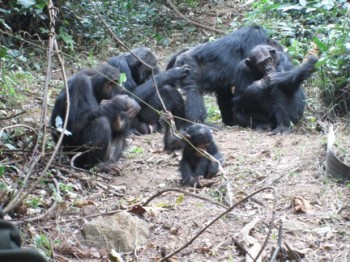One of the best parts about being a CASHP graduate student is the endless research opportunities available to us. These opportunities can come in any form, and are rarely predictable. Such was my experience, when CASHP professor Dr. Carson Murray invited me to Gombe Stream National Park in Tanzania to observe chimpanzees in the wild.
As a student interested in the evolution of technology (read: “an archaeologist”) colleagues often asked, “Why are you going to Gombe? You’re not a primatologist…” Perhaps this is true, but it is my belief that through exposure to various disciplines we can re-examine our own questions in new contexts. Plus, who on Earth would say no to seeing chimpanzees in the wild?
This unique opportunity arose mainly because I was already in Tanzania for my own research; like many other CASHP affiliates, my research questions send me to East Africa every summer to engage in archaeological excavation. Unlike many of my colleagues who work in Kenya, however, my project is based in southern Tanzania near the border of Mozambique where I’m exploring the potential for new Middle Stone Age sites.
As the project manager, I was responsible for arranging logistics: securing research permits, renting a Land Cruiser, and arranging food and lodging for our small 5-person team. This required me to spend several weeks not just in the field, but in Tanzania’s bustling business center—Dar es Salaam. Because the expedition itself wasn’t due to begin until August, I decided to make the best use of my time in Tanzania by flying west to Lake Tanganyika to visit Dr. Murray and the Gombe chimpanzees.
My experience at Gombe would not have been so meaningful had it not been for the remarkable faculty members who joined me: CASHP faculty members Dr. Carson Murray (primatologist) and Dr. René Bobe (paleoecologist) as well as Dr. Bill McGrew (primatologist) and Dr. Susana Carvalho broken (primate archaeologist) from Cambridge University.
We spent three full days following chimpanzees, and observed 27 different individuals in total. The highlight of my trip was undoubtedly the end of Day 3 when we observed two female chimpanzees using tools! The females were termite fishing: manipulating twigs and inserting them into termite mounds to fish out hundreds of termites, a delicious high-protein snack. Chimpanzee termite fishing was one of the first discoveries at Gombe, forever changing our definition of culture and what it means to be human. Today we know that several primates use tools, including leaves as sponges to soak up water, anvils to crack open nuts, and even sharpened sticks for hunting.
As if that day were not memorable enough, that evening we had dinner with yet another remarkable scholar—Dr. Jane Goodall. The first researcher at Gombe, Dr. Goodall is a pioneering primatologist and travels over 300 days of the year with her conservation initiative, the Jane Goodall Institute. Nonetheless, she somehow finds the time to return to Gombe twice a year, and I was lucky to overlap with her. As a small group of researchers from around the world, our only agenda items that night were to enjoy the sunset on Lake Tanganyika and name the newest born member of the Gombe community. Over dinner we discussed our research interests, stories from seasons past, and the future of paleoanthropology.
So, why did I go to Gombe again? Overall I can say that I left not only with beautiful pictures of chimpanzees and memories of anthropology rock stars. More importantly, I left Gombe with dozens of new research questions about my own work—questions and ideas which may not have formed had I spent my whole summer digging in an archaeological trench. The interdisciplinary nature of paleoanthropology is always apparent, and I’m thankful to be part of CASHP where such approaches are not only acknowledged, but are actually facilitated through tangible research experiences.



